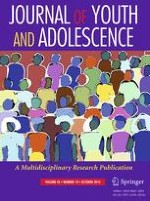18-03-2016 | Empirical Research
Mother–Child Discrepancy in Perceived Family Functioning and Adolescent Developmental Outcomes in Families Experiencing Economic Disadvantage in Hong Kong
Gepubliceerd in: Journal of Youth and Adolescence | Uitgave 10/2016
Log in om toegang te krijgenAbstract
Though growing attention has been devoted to examining informant discrepancies of family attributes in social science research, studies that examine how interactions between mother-reported and adolescent-reported family functioning predict adolescent developmental outcomes in underprivileged families are severely lacking. The current study investigated the difference between mothers and adolescents in their reports of family functioning, as well as the relationships between mother-reported and adolescent-reported family functioning and adolescent developmental outcomes in a sample of 432 Chinese single-mother families (mean age of adolescents = 13.7 years, 51.2 % girls, mean age of mothers = 43.5 years, 69.9 % divorced) experiencing economic disadvantage in Hong Kong. Polynomial regression analyses were conducted to assess whether discrepancy in family functioning between mother reports and adolescent reports predicted resilience, beliefs in the future, cognitive competence, self-efficacy and self-determination of adolescents. The results indicated that adolescents reported family functioning more negatively than did their mothers. Polynomial regression analyses showed that the interaction term between mothers’ reports and adolescents’ reports of family functioning predicted adolescent developmental outcomes in Chinese single-mother families living in poverty. Basically, under poor adolescent-reported family functioning, adolescent development would be relatively better if their mothers reported more positive family functioning. In contrast, under good adolescent-reported family functioning, adolescents expressed better developmental outcomes when mothers reported lower levels of family functioning than those mothers who reported higher levels of family functioning. The findings provide insights on how congruency and discrepancy between informant reports of family functioning would influence adolescent development. Theoretical and practical implications of the findings are discussed.
